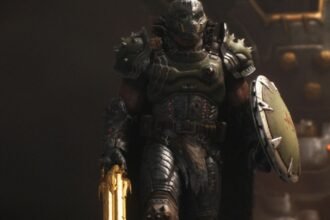In Guy Ritchie’s adventure film Fountain of Youth, characters frequently debate the idea that the excitement of the adventure is more important than the actual treasure they are pursuing. While the theme of “journey over destination” can be appealing if it leads to unexpected moments and personal growth, this movie simply drifts towards a tedious and foreseeable conclusion.
Fountain of Youth opens with promise as art thief Luke Purdue, played by John Krasinski of The Office fame, embarks on a chaotic chase through Bangkok reminiscent of Ong-Bak. Fleeing from a gang after a heist, he finds himself driving a motorcycle through a bustling market and commandeering a food truck. Immediately following this thrilling sequence is a tense fight aboard a train, where he cleverly uses a ladle to delay his opponents.
Krasinski’s adeptness at portraying a witty, self-assured character aligns well with Ritchie’s penchant for fast-talking leads, a style evident since his early films like Snatch and Lock, Stock and Two Smoking Barrels, as well as his take on Sherlock Holmes featuring Robert Downey Jr. In the initial scenes, Krasinski captures Ritchie’s essence, whether he’s defining “ambiguous” amidst hostile gangsters or engaging in flirtatious banter with Esme, played by Eiza González, who leads a group also searching for the Fountain’s secrets.
However, the excitement diminishes as the narrative devolves into tedious exposition and lackluster character development. Tasked by billionaire Owen Carver, portrayed by Domhnall Gleeson, to find the Fountain of Youth, Luke seeks assistance from his estranged sister Charlotte (Natalie Portman), hoping to reignite the adventurous spirit they shared before their father’s death. Unlike films like Indiana Jones and the Last Crusade, the 2018 Tomb Raider, and The Venture Bros., which similarly explore the complexities of involving family in quests for ancient relics, this screenplay fails to deliver depth. Written by James Vanderbilt, known for Zodiac and The Amazing Spider-Man, the script demonstrates no understanding of Charlotte’s choice to settle down and pursue a career as a museum curator, instead siding with Luke’s notion that he is inherently right and her life is unexciting.
Despite Krasinski’s chemistry with González, the sibling dynamic between Luke and Charlotte feels forced and unconvincing. Vanderbilt opts for lazy storytelling techniques like Gilligan Cuts, simply jumping ahead to show Charlotte’s presence without establishing genuine reasons for her participation in the quest. Meanwhile, Charlotte’s son Thomas, played by Benjamin Chivers, serves primarily to underscore how dull his mother is, although he does have a surprisingly engaging moment questioning Owen about his wealth. Hints regarding their father’s past and a golden mask that haunts Luke offer tantalizing possibilities but ultimately lead to no satisfying resolution or exploration of what those adventures meant to Charlotte.
The backdrop involving Charlotte’s father’s former associates could have added depth, but instead, they are merely a younger iteration of the Purdue siblings, lacking the rich history expected from characters tied to their father. Patrick Murphy, played by Laz Alonso, and Deb McCall, portrayed by Carmen Ejogo, come across as hollow iterations reminiscent of Ethan Hunt’s Mission: Impossible team, providing mere support without any substantial development or motivations.
Instead, the screenplay inundates the audience with exposition reminiscent of a Dan Brown novel, discussing an alliance of renowned artists who have concealed clues about the Fountain of Youth within their works, alongside a secret organization dedicated to concealing this power. Ritchie’s fascination with









